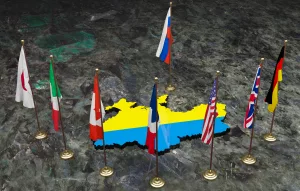Most of the world has moved on from the huge loss of life and economic disruption caused by the Covid-19 pandemic, but China remains relentlessly fixated on a policy of “Dynamic Zero Covid”. The Asia Scotland Institute held a panel discussion on 23 June for several experts to discuss trade with China in a post-Covid world. With us was Jörg Wuttke, President of the European Union Chamber of Commerce in China, and Yang Du an Associate at Moller Institute, Churchill College, University of Cambridge.
There are other pressures on economic growth that are hindering a post-Covid recovery. The OECD reported in June that Russia’s war in Ukraine is slowing economic recovery, is causing rising inflation, and has triggered a cost-of-living crisis that is affecting millions of people globally (not only in the UK).
In addition, although the world economy was on track for a strong recovery from Covid-19, the war in Ukraine as well as supply chain disruptions in China caused by the “Dynamic Zero Covid” approach are hindering recovery. Global shipping and logistics giant Maersk reported in May that despite the lockdown in Shanghai for over seven weeks the city ports continued to operate, but that truck drivers (who transport three quarters of freight in China) spent 70 per cent less time on the roads in March 2022 compared to April 2021. Ships may be able to get to China’s ports, but manufactured goods have not been able to get to the ships.
The official story from inside China is very different. The Ministry of Commerce reported in June that there should be stable growth in foreign trade this year and that “there are multiple enabling factors to stabilize foreign trade and improve trade quality”. The good economic news story, repeated across state-controlled media in China, is that exports have increased by over 15 per cent year-on-year in May, which is attributed to the control of Covid-19 cases. Zhao Ping, vice-president of the Academy of China Council for the Promotion of International Trade, said: Thanks to the huge size, firm footing and strong resilience, China’s foreign trade will keep healthy growth momentum despite challenges from the slowdown in world economic recovery and rising commodity prices.”
Variable economic growth in different countries after recovery from Covid has shown that some countries have come out of the pandemic more quickly than others. The IMF projected economic growth for the UK of 7.4 per cent in 2021, 3.7 per cent in 2022, but only 1.2 per cent for 2023. The corresponding projections for the Euro area are 5.3 per cent, 2.8 per cent, and 2.3 per cent, indicating an initially faster recovery by the UK. But economic growth projections for China are 8.1 per cent in 2021, 4.4 per cent in 2022, and 5.1 per cent in 2023. Despite “Dynamic Zero Covid”, China seems to have such a huge scale of production and range of industries that its economy is more resilient and can recover from the prolonged lockdowns.
As Jörg Wuttke pointed out recently, China depends on the European market more than Europe does on China. Europe exports goods to China valued at 600 million euros every day, but China exports 1.3 billion euros worth of goods daily to Europe.
Martin Purbrick is a consultant, analyst, and writer who spent 32 years working in Asia in corporate risk management, law enforcement, and sports integrity.
He now writes for journals and news publications, including published work in Asian Affairs, the Jamestown Foundation, the Scotsman, the South China Morning Post, and Ming Pao News. His focus is on organised crime, corruption, law enforcement, and in particular these issues in relation to China and the rest of Asia.
- Martin Purbrickhttps://asiascot.com/author/martin-purbrick
- Martin Purbrickhttps://asiascot.com/author/martin-purbrick
- Martin Purbrickhttps://asiascot.com/author/martin-purbrick
- Martin Purbrickhttps://asiascot.com/author/martin-purbrick











